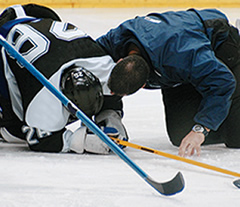Last year, Toronto neurosurgeon Dr. Charles Tator publicly criticized Hockey Night in Canada personality Don Cherry for promoting an aggressive style of hockey. Concussions have been on the rise in the sport, and Dr. Tator is trying to promote awareness of the dangers posed by even mild head injuries. A founder of ThinkFirst and SportsSmart Injury Prevention programs, he spoke recently with Daniel Baird.
What is a concussion, exactly?
It’s a mild brain injury. But part of the dilemma we face is that we don’t really understand the biology of concussions. We’ve been unable to locate the exact sites in the brain that, when injured, cause concussion. We can’t identify damage on a CT scan or MRI – despite all of the research into advanced imaging technologies, there is no physiological test for a concussion. For now, only a knowledgeable practitioner can diagnose it.
If there are no physiological tests, then how does a practitioner diagnose a concussion?
There are about 30 different symptoms, not all of them present at a given time. Some patients might have a headache; others might experience nausea, vomiting, or personality and memory changes. There are a very large number of symptoms, and they evolve over time: some might have one symptom, others might have 10; someone might not be dizzy at first, but become dizzy the next day. With first concussions, there is usually complete recovery. It might be a day or a month, but most people get over it.
What additional risks do repeated concussions pose?
Patients who suffer multiple concussions can suffer serious long-term consequences. Repeated concussions, especially after incomplete recovery, can cause dementia similar to that seen in Alzheimer’s, and depression. We’ve known about this for at least 100 years from studies of boxers – it was called dementia pugilistica. But now we know it happens in soccer, football and hockey players as well. We don’t know how many concussions some of these players have had since in many cases we have incomplete clinical records. When I interview these players, they don’t know how many times they’ve been concussed. Both patients and doctors have to be more diligent in recording this.
How are concussions treated?
The frustration is that there is zero treatment for concussion. We have nothing that completely eliminates symptoms. A lot of research is being done and there are a lot of unsubstantiated claims but no treatment, so prevention is crucial. There are, however, specific guidelines to manage concussed patients, such as when people can safely return to normal activity and playing sports. People should have complete physical and mental rest until their symptoms are gone. We feel that this period is important for the brain to recover.
What is the best way to prevent concussions, especially in popular sports such as hockey?
We recommend a whole range of activities specific to causes, like cars having side airbags and the use of seatbelts. In sports, helmets are now being used, but unfortunately there are no concussion-proof helmets, though they prevent other more serious head injuries. In hockey, banning all hits to the head would help. Information and diagnosis is important, since we still find there are hockey coaches and leagues that don’t take this seriously. Even some of my colleagues are not up to speed on this. Still, in the past 10 years there has been a marked increase in knowledge about how to manage concussions. A cultural shift is underway in sports. There are posters in NFL locker-rooms, for example, about this topic.
Recent Posts
For Greener Buildings, We Need to Rethink How We Construct Them
To meet its pledge to be carbon neutral by 2050, Canada needs to cut emissions from the construction industry. Architecture prof Kelly Doran has ideas
U of T’s 197th Birthday Quiz
Test your knowledge of all things U of T in honour of the university’s 197th anniversary on March 15!
Are Cold Plunges Good for You?
Research suggests they are, in three ways





One Response to “ Preventing Concussions ”
While improvements in equipment are important, the most obvious way to protect players is by changing and enforcing rules. Changes in mindset need to start with the youngest players and their parents. It is outrageous to hear parents cheering hard hits in pee-wee level games. It is equally outrageous to watch fans cheer fighting and hard hits along the boards at junior-level hockey games. Current research tells us that the brain of a person in their 20s is still developing. So why is checking and hitting allowed in house leagues, travel leagues, college and junior Level? If we truly want to protect players against concussions then we need to take the violence out of the game. No more checking, hitting, and fighting.